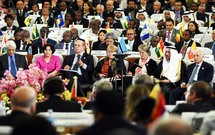 Foreign ministers from around the world gathered in Algiers on May 28-29 for the 17th Ministerial Conference of the Movement of Non-Aligned Countries. With representatives from Africa, the Middle East and Asia present, the outcomes of the meetings barely made international headlines.
Foreign ministers from around the world gathered in Algiers on May 28-29 for the 17th Ministerial Conference of the Movement of Non-Aligned Countries. With representatives from Africa, the Middle East and Asia present, the outcomes of the meetings barely made international headlines.
The Non-Aligned Movement, formed in Belgrade in 1961, was the brainchild of several national leaders who, like India's Jawaharlal Nehru, Egypt's Gamal Abdel Nasser and Indonesia's Sukarno, were part of a new generation of political leadership brought to power as colonial regimes crumbled in the 1960s. Designed as an alternative to the competing U.S. and Soviet-led alliance structures of the Cold War, the Non-Aligned Movement has struggled to define itself since the collapse of the Soviet Union in 1991. The bloc has found new life in recent years, however, as a platform for individual states' regional ambitions.
The effectiveness of multinational blocs, even regional ones, is almost universally impeded by the diverse and often competing interests of their member states. The Non-Aligned Movement is no different. Despite its stated purpose and its name, most of the states had leanings toward either the West or the Soviet bloc during the Cold War. Some members, such as India and Pakistan, Iran and Iraq, have even gone to war with one another. The movement's support of a given issue, such as advocating for Puerto Rican independence, is of little practical benefit. And though the 120 member states represent the vast majority of the United Nations' membership, the exclusion of global powers such as the United States, Western Europe, Russia and Japan limits the bloc's ability to affect global trends or to enforce its resolutions.
However, the Non-Aligned Movement still plays into the foreign policy doctrines of several key states with regional aspirations. India, a founding member, continues to pursue a doctrine of avoiding formal alliance structures, much to the consternation of the United States. However, this stance is important for a country that believes it can best guarantee its security by balancing Western encroachment against a rising China by not directly opposing either. Iran has also used its membership in the movement to avoid political isolation, expanding its ties with India, Latin America and Africa in recent years. Firebrand former Iranian President Mahmoud Ahmadinejad found several kindred spirits within the group as he made claims of U.S. imperialism and global domination.
The Non-Aligned Movement is too large and diverse to encapsulate a singular trajectory for its member states, but two aspects of the movement can provide insight into its future. First, members from the Middle East, emerging African states and members of the broader Indian Ocean community often first raise their voices within the Non-Aligned Movement summit before engaging the leaders of the international community. Second, in previous decades the group's members have been dismissed as members of the Third World, but many are now considered emerging and frontier markets. Now, the movement's organizational heft may be questioned, but the role of several of its member states within regional and international markets is growing.
Algeria, this meeting's host, played a leading role within the Non-Aligned Movement in the 1970s under the leadership of President Houari Boumediene. The Algiers Agreement saw Saddam Hussein and Shah Mohammad Reza Pahlavi agree on Iraq-Iran borders. In 1981, Washington and Tehran signed the Algiers Accords, marking the end of the Iran hostage crisis. Decades of economic downturn and civil war have limited Algiers' regional standing, but Algeria has emerged following the unrest of the Arab Spring as an ambitious regional player and key partner for Western counterterrorism efforts in North Africa. The Non-Aligned Movement is again a ready platform where Algeria, like Iran, can boost its international standing without being overshadowed by Western powers.
Despite a lackluster past, the Non-Aligned Movement could have a larger role in the future. What began as an alternative to taking sides during the Cold War has evolved into diplomatic training grounds for emerging states and a foreign policy tool for countries like Iran. The movement is not yet a powerful global player, but its opportunities for pursuing a foreign policy not centered on the United States, the European Union, Russia or China makes the bloc popular among its member states. As East Africa, India and Southeast Asia continue to develop, Russia, China and the West could realize that many of the movement's members' views in international politics will have to be taken into consideration -- especially as global leaders like the United States will increasingly look to regional partners to help achieve goals instead of taking unilateral action.
Courtesy : Stratfor (www.stratfor.com)